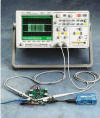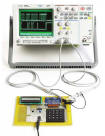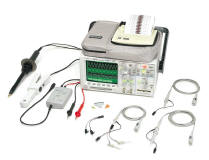| Triggering | |
| Flexible Triggering | |
|
With mixed analog and digital designs, sometimes it is hard to trace an anomaly back to its root cause unless you can trigger on it and correlate it with another signal. With the 54600-Series scopes, triggering is no longer a hassle. They come with flexible triggering capabilities across all channels so you can easily isolate and analyze complex signals and interactions common in your mixed analog and digital designs. |
|
|
|
|
|
Easily synchronize to a USB packet. |
|
| ¡@ | |
| CAN, and USB Triggering | |
|
Controller Area Network (CAN) and Universal Serial Bus (USB) triggering comes standard with the 54600-Series scopes. These triggering modes make it easy to synchronize CAN, and USB frames. Don¡¦t waste time finding the start of the complex frames. ¡@ CAN triggering synchronizes to the start of a CAN frame on any CAN high or CAN low signal. ¡@ USB is quickly becoming the connection of choice for PC peripherals. Make your testing easy with Start of Packet (SOP), End of Packet (EOP), Reset Complete (RC), Enter Suspend, or Exit Suspend modes. |
|
|
|
|
|
Make your automotive and industrial testing easier. CAN triggering synchronizes to the start of a CAN frame on any CAN high or CAN low signal. |
|
| ¡@ | ¡@ |
| I2C and SPI Triggering | |
|
Don¡¦t spend your
time sorting through communication frames to find the one of interest. Let
Agilent set up an Inter-Integrated |
|
|
|
|
| Trigger on data patterns within a SPI frame. | Trigger on address and/or data patterns within an I2C frame. |
| ¡@ | |
| Microcontroller and DSP Applications | |
|
Microcontrollers (MCUs)
and Digital Signal Processors (DSPs) are here to stay, and are becoming
more pervasive in industrial, scopes can provide. ¡@
Agilent 54621D,
54622D, 54641D, and 54642D mixed-signal oscilloscopes (MSOs) provide the
channel count, memory depth, |
|
|
|
|
|
The 350 MHz and 500 MHz MSOs are a great fit for DSP applications. |
|





